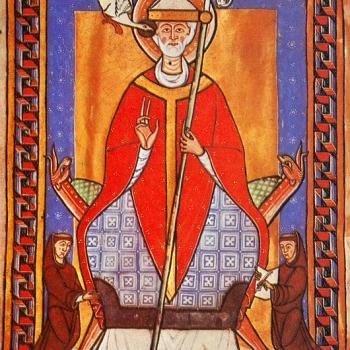I have been working on the early church, mainly the era of Tertullian, around 200 AD. What you find in that era has many implications for later debates about the church, and especially at a time when we are talking so much about commemorating the Reformation.
For Christians, the question of what the church actually did and thought in that very early era has always been a matter of significance. To varying degrees, Christians of all shades and traditions have always claimed to be grounding themselves in the Bible and the early Church. A practice is justified as authentic if it can be validated by scriptural reference, or else by the historical precedent of the early Christian centuries, and the venerated Church Fathers. The guiding principle is that the era closest to the time of Christ and his apostles was most likely to have preserved their message most faithfully and accurately.
That view was especially prominent during the Reformation of the sixteenth century. Even Protestants who claim to be following the strict practice of the New Testament acknowledge that the early church did not immediately lose or betray the glories of the apostolic age, thus granting some authority to Patristic authors. Commonly, this “early church” designation extends to what occurred before the Council of Nicea of 325 AD, creating the concept of “Ante-Nicene.”
Such a resort to the “early church” commonly features in debates over present-day ideas and practices. Roughly, if an idea or theme can be demonstrated to have been recognized in the early church – and the earlier the better – that of itself gives solid grounds for reviving or restoring it in the modern world. That approach explains the strong concern of modern-day liberals and feminists with early church history, in such crucial matters as the existence of ordained women clergy. Although such activists challenge the current state of the church and the traditions that it claims to follow, they do so by seeking the warrant of a tradition still more ancient and, in this view, authentically truer to the spirit of Jesus and his first followers. On all sides, the past is usable.
By these criteria, the state of the church as it existed around 200 AD – over a century before Nicea – is clearly a significant matter in contemporary debate. (For Americans, this approach has much in common with the Original Intent approach to the Constitution).
Several critical issues come to mind from that early Christian era, and one involves the definition of clergy. Already around 200, the concept and definition of the clergy was changing rapidly, moving in the direction of a distinct class or caste that we know from Late Antiquity and the Middle Ages. To oversimplify, that idea was already becoming quite visibly “catholic.”
To indicate just how wide such a gulf would ultimately become, we might look at conditions in the High Middle Ages, when clergy were multiply distinguished from the laity by the fact of ordination. Depending on the country in question, they were required to be celibate, they often wore distinct clothing and styles of hair or beard, and they were subject to a distinct system of justice and discipline. Clerical life had its own hierarchy and career ladder, and senior clergy normally passed through lower grades of status. Critically, clergy were literate in a society where most lay people were not. Clergy and clerk come from the same root. Reinforcing that separation, the clergy served a church that was a political and economic power in its own right, and a major landowner. Presenting such a picture highlights critical differences with ante-Nicene times, when the lay/clerical divide was narrower. But the clergy were evolving in status and distinctiveness.
Unlike the Middle Ages, literacy was widespread in Roman times, and prosperous lay people were likely to have access to books equal or superior to their clergy. Also, clergy were still not celibate. But the language of “clergy” was definitely present. In Latin, it first surfaces in Tertullian’s tract De Monogamia, written after 210. Tertullian supported the institution of marriage, but denied that Christians could remarry after a partner died. He was especially concerned about the role of bishops, priests and deacons, writing: “For whence is it that the bishops and clergy [episcopi et clerus] come? Is it not from all? If all are not bound to monogamy, whence are monogamists (to be taken) into the clerical rank? [in clerum?] Will some separate order of monogamists have to be instituted, from which to make selection for the clerical body? [clerum]”
For anyone used to later Christian history, this language of clergy and clerical order is wholly unsurprising, but it is new at this historical moment. The word also appears fully formed, in exactly the sense that it would convey in future ages. If there was a clergy, then some word was also needed for believers who did not fall into that category, and that word was “lay” or laity, from the Greek word laos. A lay person was a laikos, “one of the People,” which Tertullian imports into Latin as laicus.
Tertullian also used other terms that would become very influential as they acquired a technical meaning. In his time different groups might constitute an order, ordo, a term applied to bishops and elders (and eventually to lower clerical ranks). Admission to the ordo of clergy became ordination.
An identical usage of the term “clergy” occurs at just this time in the writings of another early father, namely Hippolytus. Around 220, he wrote a scabrous account of Callistus, Bishop of Rome (Pope) and his laxity towards sexual conduct among clerics. Callistus supposedly taught that “if a bishop was guilty of any sin, if even a sin unto death, he ought not to be deposed. About the time of this man, bishops, priests, and deacons, who had been twice married, and thrice married, began to be allowed to retain their place among the clergy [kathistasthai eis klerous]. If also, however, any one who is in holy orders [en klero] should become married, Callistus permitted such a one to continue in holy orders [en to klero] as if he had not sinned.”
I quote here the standard English translation of the text, which is loaded with technical terms for clerical status and discipline that at first glance sound almost medieval. There is a class of clergy from which one can be expelled, people are “in holy orders.” That last phrase is misleadingly medieval, and the translator has only introduced it to add some variation to Hippolytus’s frequent repetition of the word kleros, clergy. But the idea of a clerical caste or even profession is definitely present. It matters enormously whether one has fulfilled the proper qualifications for membership, and it is a public scandal that the unqualified or sinful are permitted to remain. Throughout his account, he speaks regularly of the clergy as a group, for instance in terms of the bishop’s care of his clergy, kleros.
Tertullian and Hippolytus were using the idea and institution of hierarchical “clergy” in the church of their time. And that is definitely in the era of the “early church.”
Around this time too, an even more controversial idea appeared in the Christian world view, namely Priesthood.
More on that next time.













